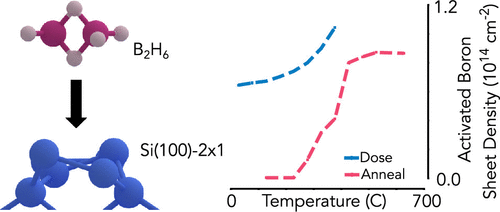当前位置:
X-MOL 学术
›
J. Phys. Chem. C
›
论文详情
Our official English website, www.x-mol.net, welcomes your
feedback! (Note: you will need to create a separate account there.)
A Model for Atomic Precision p-Type Doping with Diborane on Si(100)-2×1
The Journal of Physical Chemistry C ( IF 3.3 ) Pub Date : 2021-01-06 , DOI: 10.1021/acs.jpcc.0c08919 Quinn Campbell 1 , Jeffrey A. Ivie 2 , Ezra Bussmann 2 , Scott W. Schmucker 2 , Andrew D. Baczewski 1 , Shashank Misra 2
The Journal of Physical Chemistry C ( IF 3.3 ) Pub Date : 2021-01-06 , DOI: 10.1021/acs.jpcc.0c08919 Quinn Campbell 1 , Jeffrey A. Ivie 2 , Ezra Bussmann 2 , Scott W. Schmucker 2 , Andrew D. Baczewski 1 , Shashank Misra 2
Affiliation

|
Diborane (B2H6) is a promising molecular precursor for atomic precision p-type doping of silicon that has recently been experimentally demonstrated [Škereň Nat. Electron. 2020]. We use density functional theory (DFT) calculations to determine the reaction pathway for diborane dissociating into a species that will incorporate as electrically active substitutional boron after adsorbing onto the Si(100)-2×1 surface. Our calculations indicate that diborane must overcome an energy barrier to adsorb, explaining the experimentally observed low sticking coefficient (<1 × 10–4 at room temperature) and suggesting that heating can be used to increase the adsorption rate. Upon sticking, diborane has an ≈50% chance of splitting into two BH3 fragments versus merely losing hydrogen to form a dimer such as B2H4. As boron dimers are likely electrically inactive, whether this latter reaction occurs is shown to be predictive of the incorporation rate. The dissociation process proceeds with significant energy barriers, necessitating the use of high temperatures for incorporation. Using the barriers calculated from DFT, we parameterize a Kinetic Monte Carlo model that predicts the incorporation statistics of boron as a function of the initial depassivation geometry, dose, and anneal temperature. Our results suggest that the dimer nature of diborane inherently limits its doping density as an acceptor precursor and furthermore that heating the boron dimers to split before exposure to silicon can lead to poor selectivity on hydrogen and halogen resists. This suggests that, while diborane works as an atomic precision acceptor precursor, other non-dimerized acceptor precursors may lead to higher incorporation rates at lower temperatures.
中文翻译:

Si(100)-2×1上乙硼烷原子精密p型掺杂的模型
乙硼烷(B 2 H 6)是用于硅原子精确p型掺杂的有前途的分子前体,最近已通过实验证明[Škereň 纳特 电子。 2020 ]。我们使用密度泛函理论(DFT)计算来确定乙硼烷解离成物种的反应路径,该物种在吸附到Si(100)-2×1表面后将作为电活性取代硼结合。我们的计算表明乙硼烷必须克服能垒才能吸附,这解释了实验观察到的低粘附系数(在室温下<1×10 –4),并暗示可以利用加热来提高吸附速率。粘结后,乙硼烷有大约50%的机会分裂为两个BH 3片段,而仅损失氢而形成二聚物(例如B 2 H 4)。由于硼二聚体很可能是无电的,因此后一种反应是否发生可预测掺入率。离解过程以明显的能量垒进行,因此必须使用高温进行掺入。使用从DFT计算的势垒,我们对动力学蒙特卡洛模型进行了参数化,该模型预测了硼的掺入统计量是初始钝化几何形状,剂量和退火温度的函数。我们的结果表明,乙硼烷的二聚体性质固有地限制了其作为受体前体的掺杂密度,此外,在暴露于硅之前加热硼二聚体分裂会导致对氢和卤素抗蚀剂的选择性差。这表明,尽管乙硼烷是原子精确受体的前体,
更新日期:2021-01-14
中文翻译:

Si(100)-2×1上乙硼烷原子精密p型掺杂的模型
乙硼烷(B 2 H 6)是用于硅原子精确p型掺杂的有前途的分子前体,最近已通过实验证明[












































 京公网安备 11010802027423号
京公网安备 11010802027423号